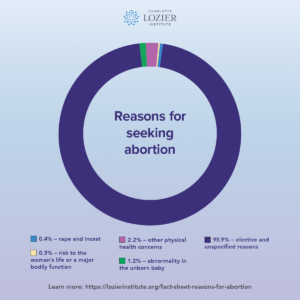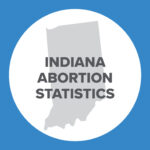Fact Sheet: Reasons for Abortion
Originally published on August 17, 2022, this fact sheet was updated on January 14, 2023, and again on May 24, 2024.

After the Supreme Court ruling in Dobbs v. Jackson Women’s Health Organization, states across the country have enacted laws that limit abortion. Frequently, these state laws make exceptions for abortions for certain reasons, such as rape and incest, risk to the mother’s life or health, or a fetal abnormality. Assessing the number of abortions performed for various reasons can be challenging due to the poor quality of U.S. abortion data resulting from inconsistent reporting requirements. Periodic surveys by pro-abortion organizations have been done of women visiting abortion centers.[1], [2] However, these surveys do not provide a detailed look at abortions specifically performed for common legal exceptions.
For this report, we compiled publicly available data from the eight states that collected and reported 2021 data on women’s reasons for choosing abortion. We selected data from 2021, the year before Dobbs was decided, because many of these states limited abortion after Dobbs. These eight states accounted for approximately 123,000 abortions in 2021, which would have been around 13% of the U.S. total in 2020.[3], [4] Some of these states allow women to report multiple reasons for an abortion or to write in a particular reason, while others ask women to select the top reason or choose from a predetermined list. Additionally, some states provide more precise reasons than others. To develop an estimate of the percent of abortions performed for a given reason, data was combined from each state reporting that particular reason.
Overall, common exceptions to abortion limits are estimated to account for less than 5% of all abortions.
- Rape and incest: 0.4%[5]
- Risk to the woman’s life or a major bodily function: 0.3%[6]
- Other physical health concerns: 2.2%[7]
- Abnormality in the unborn baby: 1.2%[8]
- Elective and unspecified reasons: 95.9%[9]
This could underestimate the number of abortions performed for each of these reasons, however, because in some states a significant percentage of women declined to share a reason. Conversely, abortions for these reasons could be overestimated, since in states that permit multiple reasons to be reported, a single abortion could have been performed for more than one of these reasons. However, in Florida, which allows only one reason for each abortion and requires an abortion provider to list a reason before the abortion report form can be submitted, abortions for reasons that correspond to common exceptions accounted for less than 3% of the total in 2021.
Due to the voluntary nature of state abortion reporting, the total number of abortions estimated by the Guttmacher Institute in 2020 (the most recent year in which Guttmacher administered its full abortion facility survey) is 50% higher than the official U.S. total from the Centers for Disease Control and Prevention (CDC), which monitors U.S. abortion trends.[10] The CDC does not request information on reasons for abortion from the states, and so this data is not included in the national reports. As the Dobbs decision has resulted in a shift in where and why abortions are performed and the complications that are associated with them, the CDC should strengthen reporting requirements and request additional data from the states.[11]
[1] Finer LB, Frohwirth LF, Dauphinee LA, Singh S, Moore AM. Reasons U.S. women have abortions: quantitative and qualitative perspectives. Perspect Sex Reprod Health. 2005;37(3):110-118. doi:10.1363/psrh.37.110.05.
[2] Biggs MA, Gould H, Foster DG. Understanding why women seek abortions in the US. BMC Womens Health. 2013; 13:29. doi:10.1186/1472-6874-13-29.
[3] Arizona (2021), Florida (2021), Louisiana (2021), Minnesota (2021), Nebraska (2021), Oklahoma (2021), South Dakota (2021), Utah (2021).
[4] According to the Guttmacher Institute, there were an estimated 930,160 abortions in the United States in 2020. See: Jones RK, Philbin J, Kirstein M, Nash E, Lufkin K. Long-term decline in US abortions reverses, showing rising need for abortion as Supreme Court is poised to overturn Roe v. Wade. Guttmacher Institute. June 15, 2022. Accessed August 11, 2022. https://www.guttmacher.org/article/2022/06/long-term-decline-us-abortions-reverses-showing-rising-need-abortion-supreme-court.
[5] Data from eight states with 122,773 total abortions (AZ, FL, LA, MN, NE, OK, SD, UT). Reasons of domestic violence and abuse are included in these totals. The number of abortions performed on state residents in Utah in the case of rape is suppressed because it is so small.
[6] Data from six states with 101,433 total abortions (FL, MN, NE, OK, SD, UT).
[7] Data from six states with 119,603 total abortions (AZ, FL, LA, MN, NE, OK).
[8] Data from eight states with 122,773 total abortions (AZ, FL, LA, MN, NE, OK, SD, UT). SD does not include fetal abnormality as a reason, but separately reports the number of abortions performed on babies with abnormalities.
[9] Abortions for the reasons listed above subtracted from 100%. Abortions for which no particular reason was reported are included in the “elective and unspecified reasons” total.
[10] Guttmacher estimates 930,160 abortions in 2020, while the CDC reports 620,327. See: Kortsmit K, Nguyen AT, Mandel MG, et al. Abortion Surveillance — United States, 2020. MMWR Surveill Summ 2022;71(No. SS-10):1–27. doi:10.15585/mmwr.ss7110a1.
[11] For additional state-level information, please see: https://lozierinstitute.org/state-abortion-reporting/.






























